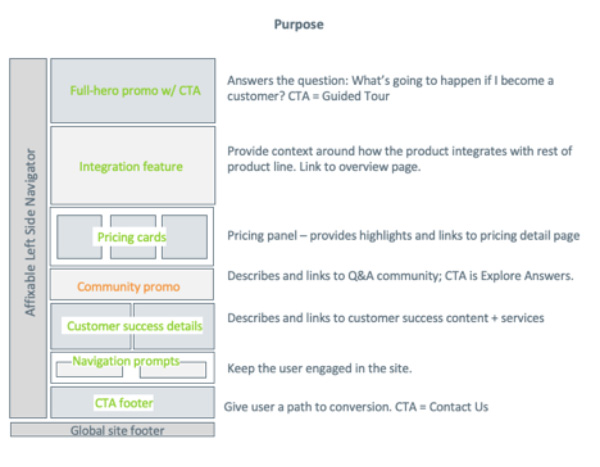What Is a Content Model?
A content model is a visual representation of the way that content should be structured on a webpage. It is a planning tool used at the outset of a project to guide the wireframing, design, and content creation on a page.
Combined with the information architecture, the right content model or content architecture helps make content more findable, accessible, and usable within a site and on each different page template.
A content model can:
- Define the purpose of a page.
- Show what content should be on a page.
- Establish the on-page information hierarchy.
- Identify core and optional content elements.
- Standardize nomenclature of content elements.
- Provide a purpose for every content element on the page.
- Prevent design conflicts and layout issues.
- Ensure that content elements meet overall UX goals.
Content Model Example
Content models can take many forms, depending on your project and goal. At Tendo, we offer different versions, depending on the client and the project. Below is an example of a mid-fidelity content model, which offers some idea of what a finished layout might look like but doesn’t dictate design. A high-fidelity content model might resemble a wireframe, while the most basic content models simply list the hierarchy of content elements on a page.

Why Content Models Matter for B2B Companies
Content models help B2B companies create consistent, easy-to-navigate webpages that address the needs and tasks of visitors, who may be researching your product or service or evaluating a purchase decision. Giving considered thought to the information on a page and how it helps users accomplish their tasks can lead to a better customer experience and in turn, increased sales. If users are confused by a page or don’t get the information they need at their stage of the customer journey, it can result in frustration, a lost sale, and eroded trust in the brand.
Faced with longer decision-making processes and a wealth of information to convey (including features, integration, regulatory information, and complex pricing), B2B marketers can’t afford to jump into content creation without a plan. Creating a content model ensures that the most important content is provided up front and that your content follows a natural narrative arc.
Need Help Structuring Your Content?
Tendo’s user experience services, which includes content modeling, have helped world-class B2B brands better support and connect with their customers. Let us know what your needs and goals are—contact us today.

